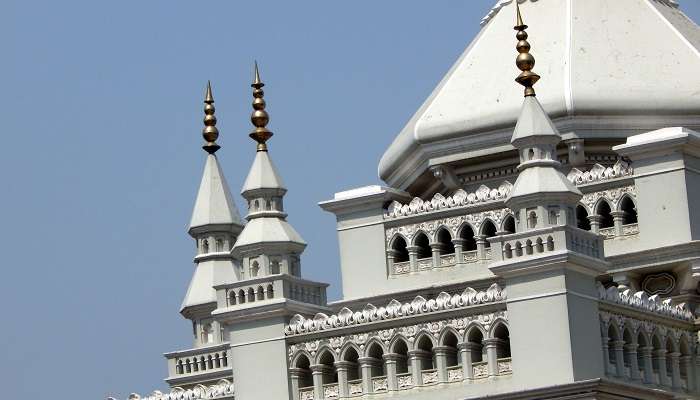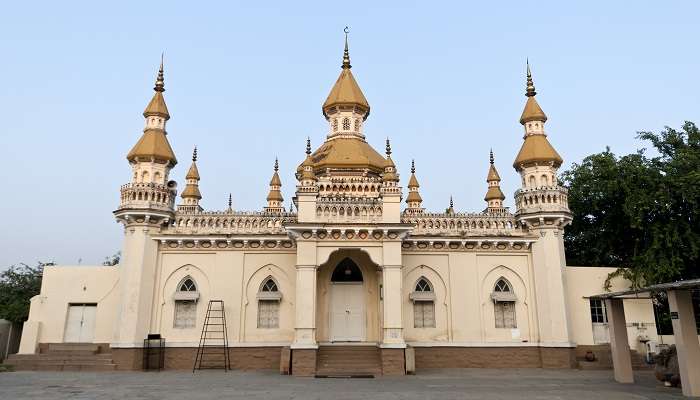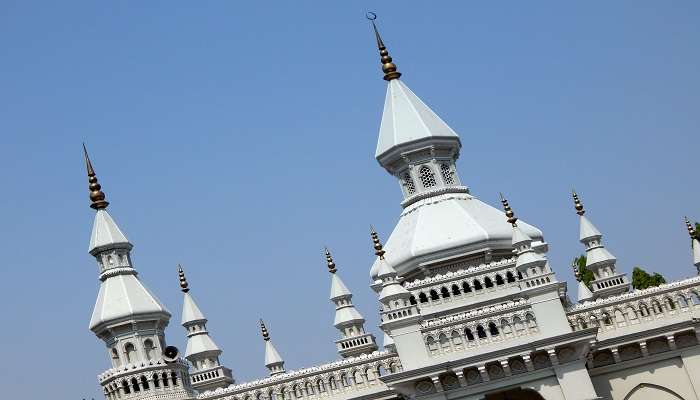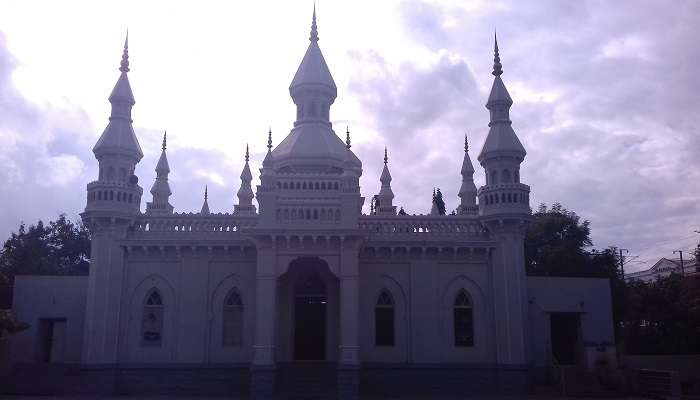Explore The Majestic Spanish Mosque In Hyderabad In 2025

Nestled in the heart of Hyderabad stands a remarkable architectural gem that effortlessly showcases both Islamic and Spanish architecture – the Spanish Mosque. Also known as Masjid Iqbal Ud Daula or Jam-e-Masjid Aiwan-e-Begumpet, this stunning mosque symbolises the city’s rich heritage. With its striking white facade, detailed geometric patterns, and soaring minarets, the Spanish Mosque Hyderabad instantly captivates visitors, transporting them to serenity and spiritual reflection. The mosque’s unique architecture draws inspiration from the iconic Andalusian style, reminiscent of the grand mosques of Spain, while incorporating elements of traditional Islamic design, from its inception in the early 20th century to its role as a symbol of unity in Hyderabad.
About Spanish Mosque Hyderabad

The Spanish Mosque, also known as Masjid Iqbal Ud Daula or Jam e Masjid Aiwan-E-Begumpet, is a unique and fascinating landmark in Hyderabad in India. Built in 1906, it stands within the grounds of the Paigah Palace in the Begumpet neighbourhood.
The mosque stands out for its architectural style, blending Moorish design from Spain with elements of Mughal architecture. It features vibrant mosaic tiles, detailed horseshoe arches, and grand domes, including a unique central dome.
The Spanish Mosque is not only beautiful but also spacious, able to hold about 3,000 worshippers inside. It’s an important place of worship for the local Muslim community and a notable landmark in the city.
Must Read: Things To Do In Hyderabad
History Of Spanish Mosque Hyderabad

The Spanish Mosque in Hyderabad stands as a unique testament to cross-cultural inspiration. Its story begins in 1900 with Sir Viqar ul Umra, the fifth Paigah Amir and the then Prime Minister of the Nizam. A visit to Spain enthralled him with the architectural marvel, the Córdoba Cathedral-Mosque. Upon his return, brimming with inspiration, he commissioned the construction of a mosque that would echo the essence of what he had witnessed. Sadly, Sir Viqar ul Umra passed away in 1902, but his vision lived on. His son and heir, Nawab Sultan Ul Mulk Bahadur, along with Sir Viqar ul Umra’s wife, Princess Jahandarunissa Begum, ensured the project’s completion in 1906. While the inspiration came from Spain, the influences are not purely European. The Spanish Mosque pays homage to Moorish architecture. This style flourished in the Iberian Peninsula due to its Islamic presence for centuries.
This is evident in the use of horseshoe-shaped arches, a signature element. Interestingly, the mosque also showcases similarities to Jama Masjid Gulbarga in Karnataka, India. Today, the responsibility of its upkeep falls upon Mr. Faiz Khan, a trustee of the mosque and a descendant of the Paigah family. The Spanish Mosque remains a captivating landmark in Hyderabad. In this place, history and architecture come together in a truly unique way.
Architecture Of Spanish Mosque Hyderabad

The Mosque, often called the Mosque of the Moors, stands out for its unique Hispanic (Moorish) architectural style, making it a singular landmark in India. One of its most distinctive features is its spires, which impart a church-like appearance, contrasting with most mosques’ typical minarets or domes. Since its inception, the Mosque has been maintained and managed by the successors of Paigah Amir Sir Viqar-ul-Umra. Constructed in 1906, the Mosque showcases unique horseshoe-shaped arches, evocative of Moorish architecture from North Africa. One of the first things you’ll notice about the Spanish Mosque is its lack of conventional domes and minarets. The central dome of the Spanish Mosque is adorned with a perforated screen. The columns mirror the octagonal shape of the upper dome. The Spanish Mosque uses stone masonry up to the basement level and brick masonry with lime mortar for the superstructure. The roof is made of brick and lime concrete with a jack arch design supported by iron girders.
Brick and stone masonry are used to construct the domes, minarets, and minor turrets, with lime mortar plastering the exterior. The exteriors are adorned with spiralling patterns that create a mesmerising interplay of golden and pale yellow hues. The spires display an interesting interplay of golden and pale yellow hues, complemented by jalidar or lattice panels. With its arches and pillars, the hall of the Spanish Mosque exudes a distinctly European ambience. Unlike the usual Arabic calligraphy, the walls of the Spanish Mosque feature Turkish calligraphy. The space between these spirals is filled with intricate Jali work, a form of latticework that adds a touch of elegance, and you’ll find an expansive hall with a distinctly European vibe.
Suggested Read: Places To Visit In Hyderabad
Spanish Mosque Hyderabad Timings And Best Time To Visit

The Spanish Mosque in Hyderabad is open daily from 5:00 AM to 9:00 PM, allowing visitors ample time to explore its architecture and historical significance throughout the week. The best time to visit is during the cooler months from October to March, when the weather is pleasant, making it ideal for sightseeing.
How To Reach

To reach the Spanish Mosque in Hyderabad, you have several transportation options:
By Air: Arrive at Rajiv Gandhi International Airport and then take a taxi or bus to the city centre. From there, proceed to Prakasham Nagar, where the mosque is located.
By Train: The nearest railway station is Sanjeevaiah Park Railway Station, around 2 Km from the mosque. Take a local train to Begumpet station and then take an auto-rickshaw to Prakasham Nagar, where the mosque is situated.
By Bus: Buses ply to Prakash Nagar South Bus Stop. You can walk or take an auto-rickshaw to reach the mosque.
By Road: If you’re driving, navigate to Prakasham Nagar, Begumpet, where the mosque is located. Parking facilities may be available nearby for your convenience.
Further Read: Offbeat Places In Hyderabad
The Spanish Mosque Hyderabad is a remarkable testament to the city’s rich cultural heritage and architectural brilliance. The Mosque’s intricate details, stunning tile work, and serene ambience make it a must-visit destination for anyone exploring Hyderabad. If you find yourself enchanted by the beauty and history of the Spanish Mosque, why not plan a trip to Hyderabad? This vibrant city has so much to offer, from its iconic landmarks and delectable cuisine to its warm hospitality and thriving arts scene. Book your Hyderabad getaway today and immerse yourself in the magic of this incredible destination.
For our editorial codes of conduct and copyright disclaimer, please click here.
Cover Image Credit: Sriharsha for wikimedia commons
Frequently Asked Questions About Spanish Mosque Hyderabad
Why is the Spanish Mosque famous?
The Spanish Mosque, also known as Masjid Iqbal Ud Daula, is famous for its unique architectural style. It combines Mughal elements with Moorish architecture, which is prominent in Spain and Portugal. This creates a visually stunning mosque with features like horseshoe arches, geometric patterns, and colourful tiles, making it a landmark in Hyderabad.
What is the history of the Spanish Mosque in Hyderabad?
The Spanish Mosque, commissioned in 1906 by Sir Viqar ul Umra, the prime minister of the Hyderabad Nizam at the time, has an interesting backstory. Inspired by the Córdoba Cathedral-Mosque in Spain, Sir Viqar ul Umra envisioned a mosque that combined these two architectural influences. Though he passed away before its completion, his vision was realised, resulting in this unique structure.
Which is the most beautiful mosque in Hyderabad?
Hyderabad boasts several beautiful mosques, and the concept of 'most beautiful' depends on individual taste. However, the Spanish Mosque stands out for its unique blend of various architectural styles and its well-preserved interiors. Other contenders for the title include the Charminar and the Mecca Masjid, each with their architectural grandeur.
Which is the first Masjid of Hyderabad?
The earliest recorded mosque in Hyderabad is the Khair-un-nissa Mosque, built in 1578 by a woman named Khair-un-nissa. It's a relatively small structure compared to the city's grander mosques, but it holds historical significance as the first documented mosque in Hyderabad.
Where did Muslims in Hyderabad come from?
Hyderabad has a rich and diverse history, with Muslims forming a significant part of the population. The city's Muslim community has roots in various regions, including Arabia, Persia, Central Asia, and Deccan. Over centuries, traders, missionaries, and rulers from these regions contributed to the growth of the Muslim population in Hyderabad.
People Also Read:
Mosques In Turkey Mosques In Russia Mosques In New Zealand

Unveil the hidden treasures of the globe and turn every travel dream into reality. As a Content Writer, I am passionate enough to craft stories from ancient wonders to modern marvels. My words paint the picture-perfect itinerary for unforgettable experiences. Let my words be your trusted guide to immerse in the diverse culture and discover the beauty of the unknown.











